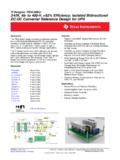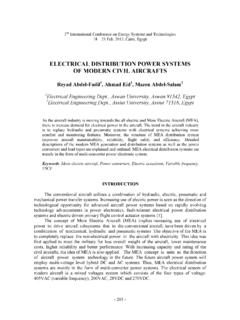Transcription of High-Speed, Microcontroller-Adaptable, Pulse Width …
1 2004-2013 Microchip Technology 1 MCP1630/MCP1630 VFeatures high - speed PWM Operation (12 ns Current Sense to Output Delay) Operating Temperature Range:- -40 C to +125 C Precise Peak Current Limit ( 5%) (MCP1630) Voltage Mode and Average Current Mode Control (MCP1630V) CMOS Output Driver (drives MOSFET driver or low-side N-channel MOSFET directly) External Oscillator Input (from PIC Microcontroller (MCU)) External Voltage Reference Input (for adjustable voltage or current output application) Peak Current Mode Operation > 1 MHz Low Operating Current: mA (typ.) Fast Output Rise and Fall Times: ns and ns Undervoltage Lockout (UVLO) Protection Output Short Circuit Protection Overtemperature ProtectionApplications Intelligent Power Systems Smart Battery Charger Applications Multiple Output/Multiple Phase Converters Output Voltage Calibration AC Power Factor Correction VID Capability (programmed and calibrated by PIC microcontroller) Buck/Boost/Buck-Boost/SEPIC/Flyback/Isol ated Converters Parallel Power SuppliesRelated Literature MCP1630 NiMH Demo Board User s Guide , Microchip Technology Inc.
2 , DS51505, 2004 MCP1630 Low-Cost Li-Ion Battery Charger User s Guide , Microchip Technology Inc., DS51555, 2005 MCP1630 Li-Ion Multi-Bay Battery Charger User s Guide , Microchip Technology Inc., DS51515, 2005 MCP1630 Dual Buck Demo Board User s Guide , Microchip Technology Inc., DS51531, 2005 DescriptionThe MCP1630/V is a high - speed Pulse Width Modula-tor (PWM) used to develop intelligent power used with a microcontroller unit (MCU), theMCP1630/V will control the power system duty cycle toprovide output voltage or current regulation. The MCUcan be used to adjust output voltage or current, switch-ing frequency, maximum duty cycle and other featuresthat make the power system more applications include smart battery chargers,intelligent power systems, brick dc/dc converters, acpower-factor correction, multiple output power supplies,multi-phase power supplies and MCP1630/V inputs were developed to be easilyattached to the I/O of a MCU.
3 The MCU supplies theoscillator and reference to the MCP1630/V to providethe most flexible and adaptable power system. Thepower system switching frequency and maximum dutycycle are set using the I/O of the MCU. The referenceinput can be external, a D/A Converter (DAC) output oras simple as an I/O output from the MCU. This enablesthe power system to adapt to many external signalsand variables in order to optimize performance andfacilitate operating in Current mode, a precise limit is seton the peak current. With the fast comparator speed (typically 12 ns), the MCP1630 is capable of providing atight limit on the maximum switch current over a wideinput voltage range when compared to other high -speedPWM Voltage mode or Average Current modeapplications, the MCP1630V provides a larger range forthe external ramp protection features include.
4 UVLO,overtemperature and Type8-Lead DFN12348765 FBCSOSC INCOMPVINVREFVEXTGND12348765 FBCSOSC INCOMPVINVREFVEXTGND8-Lead MSOP(2 mm x 3 mm) high - speed , Microcontroller- adaptable , Pulse Width ModulatorMCP1630/MCP1630 VDS21896C-page 2 2004-2013 Microchip Technology Block Diagram MCP1630 MCP1630 high - speed PWM RSQQEA+ VREFFBComp+ CSOSC INVINCOMPGNDVEXT2R RVIN ClampOvertemperatureUVLO100 k AVINVINL atch Truth TableSRQ00Qn011100111 Note:During overtemperature, VEXT driver is 2004-2013 Microchip Technology 3 MCP1630/MCP1630 VFunctional Block Diagram MCP1630 VMCP1630V high - speed PWM RSQQEA+ VREFFBComp+ CSOSC INVINCOMPGNDVEXTVIN ClampOvertemperatureUVLO100 k AVINVINL atch Truth TableSRQ00Qn011100111 Note:During overtemperature, VEXT driver is 4 2004-2013 Microchip Technology Application Circuit MCP1630+VBATTMCP1630+5V BiasPIC16LF8181/2 MCP6042+8V to +15V Input VoltageMCP1630 NiMH Battery Charger and Fuel Gauge Application Diagram4 NiMH CellsN-channel1.
5 1 SEPIC ConverterCinCOUTA/DPWM OUTA/DVDDI2C To System+ + VDDCC+ +5V Bias3V0V1/2 MCP6042 VDD+ INVREF 2004-2013 Microchip Technology 5 MCP1630/MCP1630 VTypical Application Circuit - MCP1630 VBidirectional Power Converter/Battery Charger for 4-Series Cell Li-Ion Batteries++ Battery Protection and Monitor+VBATT-VBATTB idirectional Buck/BoostLCOUTCINDC Bus VoltageSMBus4-Cell Li-Ion Battery PackBattery Protection Switches RSENSE+ BoostBuckBoost SwitchBuck SwitchSMBusISENSEVSENSEFuseGNDSync. FET Driver CompFBCSVREFOSCGNDVEXTVIN+ + + VREFC harge Current LoopDC bus Voltage Loop0V to Voltage (PWM)+ Filter+DC Bus VREFPIC16F88 MCP1630 VPS501(1/2) MCP6021(1/2) MCP6021(1/2) MCP6021 MCP1630/MCP1630 VDS21896C-page 6 2004-2013 Microchip Technology CHARACTERISTICSA bsolute Maximum Ratings Voltage on Any Pin.
6 (VGND - )V to (VIN + )VVEXT Short Circuit Current ..Internally LimitedStorage temperature ..-65 C to +150 CMaximum Junction Temperature, +150 CContinuous Operating Temperature Range ..-40 C to +125 CESD protection on all pins, HBM 3kV Notice: Stresses above those listed under MaximumRatings may cause permanent damage to the device. This isa stress rating only and functional operation of the device atthose or any other conditions above those indicated in theoperational listings of this specification is not to maximum rating conditions for extended periodsmay affect device CHARACTERISTICSE lectrical Specifications: Unless otherwise noted, VIN = to , FOSC = 1 MHz with 10% Duty Cycle, CIN = F,VIN for typical values = , TA= -40 C to +125 VoltageInput Operating Quiescent CurrentI(VIN) , FOSC IN=0 HzOscillator InputExternal Oscillator RangeFOSC 1 MHzNote 1 Min.
7 Oscillator high TimeMin. Oscillator Low TimeTOH_MINTOL_MIN 10nsOscillator Rise 10 sNote 2 Oscillator Fall 10 sNote 2 Oscillator Input Voltage Low VL Input Voltage VOscillator Input CapacitanceCOSC5pfExternal Reference InputReference Voltage InputVREF0 VINVNote 2, Note 3 Error AmplifierInput Offset +4mVError Amplifier PSRRPSRR8099 dBVIN= to , VCM= Mode Input RangeVCMGND - VINVNote 2, Note 3 Common Mode Rejection Ratio 80 dBVIN=5V, VCM= 0V to Voltage GainAVOL8595 dBRL=5k to VIN/2, 100 mV < VEAOUT < VIN - 100 mV, VCM= OutputVOL 25 GND + 50mVRL = 5 k to VIN/2 Gain Bandwidth ProductGBWP MHzVIN=5 VError Amplifier Sink CurrentISINK511 mAVIN=5V, VREF= , VFB= , VCOMP= Amplifier Source CurrentISOURCE-2-9 mAVIN=5V, VREF= , VFB= , VCOMP= , Absolute ValueNote 1:Capable of higher frequency operation depending on minimum and maximum duty cycles :External oscillator input (OSC IN) rise and fall times between 10 ns and 10 s used for characterization testing.
8 Signal levels between and with rise and fall times measured between 10% and 90% of maximum and minimum values. Not production :The reference input of the internal amplifier is capable of rail-to-rail operation. 2004-2013 Microchip Technology 7 MCP1630/MCP1630 VTEMPERATURE SPECIFICATIONSC urrent Sense InputMaximum Current Sense by maximum error amplifier clamp voltage, divided by From CS to VEXTMCP1630 TCS_VEXT 1225nsMaximum Current Sense Signal > CS input range limited by comparator input common mode range. VCS_MAX= From CS to VEXTMCP1630 VTCS_VEXT Duty CycleDCMIN 0 %VFB=VREF+ ,VCS=GNDC urrent Sense Input Bias CurrentICS_B AVIN=5 VInternal DriverRDSON P-channelRDSon_P 1030 RDSON N-channelRDSon_N 730 VEXT Rise TimeTRISE nsCL= 100 pFTypical for VIN=3 VVEXT Fall TimeTFALL nsCL= 100 pFTypical for VIN=3 VProtection FeaturesUnder Voltage falling, VEXT low state when in UVLOU nder Voltage Lockout Hysteresis UVLO HYS5075150mVThermal ShutdownTSHD 150 CThermal Shutdown HysteresisTSHD_HYS 18 CElectrical Specifications: VIN = to , FOSC = 1 MHz with 10% Duty Cycle, CIN = F.
9 TA= -40 C to +125 RangesOperating Junction Temperature RangeTA-40 +125 CSteady stateStorage Temperature RangeTA-65 +150 CMaximum Junction Temperature TJ +150 CTransientThermal Package ResistancesThermal Resistance, 8L-DFN(2 mm x 3 mm) JA C/WTypical 4-layer board with two interconnecting viasThermal Resistance, 8L-MSOP JA 208 C/WTypical 4-layer boardAC/DC CHARACTERISTICS (CONTINUED)Electrical Specifications: Unless otherwise noted, VIN = to , FOSC = 1 MHz with 10% Duty Cycle, CIN = F,VIN for typical values = , TA= -40 C to +125 1:Capable of higher frequency operation depending on minimum and maximum duty cycles :External oscillator input (OSC IN) rise and fall times between 10 ns and 10 s used for characterization testing.
10 Signal levels between and with rise and fall times measured between 10% and 90% of maximum and minimum values. Not production :The reference input of the internal amplifier is capable of rail-to-rail 8 2004-2013 Microchip Technology PERFORMANCE CURVESNote: Unless otherwise noted, VIN = to , FOSC = 1 MHz with 10% Duty Cycle, CIN = F, VIN for typicalvalues = , TA= -40 C to +125 2-1:Input Quiescent Current vs. Input 2-2:Input Quiescent Current vs. Input 2-3:Error Amplifier Frequency 2-4:Error Amplifier Input Bias Current vs. Input 2-5:Error Amplifier Sink Current vs. Input 2-6:Error Amplifier Source Current vs.















